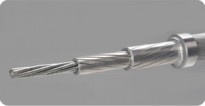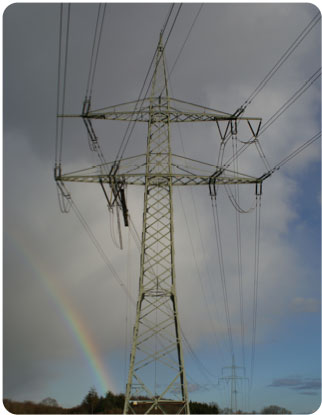Over recent years Transmission System Operators and distributors of electricity have been faced with an increasing power demand and changing power flows. At the same time the effects of the liberalisation of the energy market and emerging renewable power producers have forced grid owners to look for cost effective and reliable solutions.
In most countries erection of new overhead lines and even modification of existing ones are no longer accepted. Utilities are therefore looking for ways to increase the capacity of existing overhead lines within the limits imposed by laws and regulations.
A way to increase the capacity of existing lines is to replace the installed conductors by better performing ones. Lamifil has a broad range of solutions to increase the capacity of existing lines: extra high conductivity AAAC conductors, compacted conductors and low sag high ampacity conductors.
History
Nearly 40 years ago the GAP Conductor was developed as a low sag conductor. With the development of the heat resistant aluminium zirconium alloys and fine tuning of non-round trapezoidal wires, the design of this conductor was reconsidered resulting in the G(Z)TACSR conductor with trapezoidal aluminium zirconium wires in all layers.
Benefits
Thanks to the operating temperatures of up to 210°C these conductors can withstand, the GAP conductor design offers the possibility to increase the capacity of existing lines by 50 to 100% for the same conductor size while providing excellent sag characteristics.
Replacing the installed conductors by G(Z)TACSR is a very cost-effective solution to up rate existing transmission lines in a short time frame. Modification or reinforcement of the towers is very limited or not required.
Construction
The Gap conductor consists of a core of high strength steel, surrounded by a small gap filled with temperature resistant grease and, stacked around this gap, circular layers of trapezoidal aluminium alloy wires. The filling factor of the AlZr layers can reach 98.5% giving the possibility to make optimal use of the maximum acceptable outer diameter of the conductor. The aluminium “tube” formed by the trapezoidal wires allows the AlZr layers to move freely over the steel core.
Performance
With the same tower loadings a GZTACSR conductor can carry up to two times the rating of a conductor with the same diameter it would replace. The graph below is showing sag, tension and capacity of a twin GZTZACSR “Matthew” conductor (2 x 620mm2 – yellow curve) compared to a triple Araucaria AAAC conductor (3 x 821mm2 – blue curve).
Mechanical and electrical characteristics
The aluminium alloy used for the trapezoidal wires is aluminium zirconium. This can be either Tal or Z-Tal depending on the current carrying capacity increase required. For both Tal and ZTal the strength characteristics are not reduced by thermal cycles up to the maximum temperature given in the table below.
Above the stringing temperature the thermal expansion characteristic of the gap conductor is that of the steel core, which allows a small sag at high operating temperatures. Below the stringing temperature the characteristics are the same as for a mechanically equivalent ACSR conductor. In heavy load conditions (low temperatures, heavy wins, ice) the aluminium is contributing to the strength of the gap conductor.
Installation
To a large extent the installation of a gap conductor and an ACSR are similar. The difference is that at the moment of installation all tension is applied to the steel core on which a steel dead-end clamp is compressed. The aluminium part is left hanging on the steel core as a dead weight. After an overnight settlement period, the aluminium sleeves are compressed over the conductor and the steel
Training and supervision
For contractors having little or no experience with the installation of gap conductors Lamifil can facilitate training of personnel as well as supervision during the installation. Our objective in this matter is to transfer installation know-how to the customer, which will allow the contractor to develop his skills and execute future projects on his own.
Line hardware
Most parts of the insulator strings used with gap conductors are similar to the ones used for ACSR. The only item which is of a different design is the compression dead end clamp. Line hardware for gap conductors is manufactured by most of the traditional manufacturers of line hardware for conventional conductors.
Where more than 6 suspension towers follow each other, a semi tension or semi strain set is required.
When an ACSR is replaced by a G(Z)TACSR line hardware can be re-used with the exception of the compression dead end clamps, which are specific for a gap conductor.
Experience
In the UK Lamifil have supplied approximately 1000 metric tonnes of GZTACSR “Matthew” conductor for the increase of the transmission capacity between, the 400kV substations Deeside and Daines, Heysham B (Power Station) and Stannah-Penwortham and Quernmore Tee-Penwortham.



